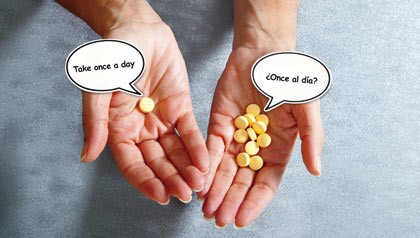Prescriptions can be Hazardous to your Health
Medical Pharmaceutical Translations • Jun 29, 2016 12:00:00 AM

An anemic patient is unable to recover because he isn’t taking the prescribed amount of the supplement given to him by his doctor because he received confusing prescription instructions from the pharmacy.
A mother guesses at the dosage of an antibiotic to give her 8- year- old feverish child because she could not understand the prescription she was given.
We have all heard about or received confusing medical information. Just imagine how difficult it must be for someone who doesn’t speak English, the language used in most prescription information inserts and documentation. According to the National Health Law Program, approximately 4 billion prescriptions are written every year in the United States and many of those are written for the 24 million who do not speak English or who are limited English Proficient (LEP). And these prescriptions are not always taken as prescribed. Many are hazardous to their health.
This was the thought behind the laws enacted to make sure pharmacies provide prescription label translations. In 2009, New York Mayor Bloomberg signed such a law stating that prescription labels and written information must be offered in the top seven languages spoken in New York City.
Other states have created similar laws as well. However, not every prescription label is being translated properly and this causes everything from confusion to death. In a 2010 study published in “Pediatrics” magazine, Dr. Iman Sharif, a Delaware-based doctor and Julia Tse, a researcher affiliated with Dartmouth College, headed to the boroughs of New York where approximately 44% of the population use Spanish as their primary language. They examined prescription translations to gauge the success of the law. Their results? Not good. A lot was being lost in translation. Here is what they found:
Law? What law? First, Sharif and Tse found that approximately 25 % of the pharmacies were not following the law and did not offer prescription translations.
Computer Translations Abound Of those that did provide prescription label translation, over 80% used computer translations instead of professional human translators. Only about 3% used human translators. Other methods included asking coworkers who took Spanish in high school or lay people (such as the Mexican restaurant owner down the street) to translate the prescriptions.
Looking at 76 different prescription labels, the study found that the computer translations generated many mistakes. Half of the prescription translations they studied had errors. Six had grammatical and spelling mistakes and over 30 were missing information.
Poor Translations at best
The 13 different computer translation programs used by pharmacies consistently created nonsensical instructions.
One example included the mistranslation of the word “boca,” or “mouth” in Spanish. The patient needed to take the medication by mouth daily, but the translation used the Spanish word “poca,” or little.
Another label was translated from English to Spanish and then checked using back translation. Here is an example:
The original English Prescription read, “ferrous sulfate (15 mg/0.6 mL), 0.6 mL administered orally twice per day; give with juice.” After it was back translated from the computer generated translation, it read, “0.6 mL mouth two kiss aldia”
Another label told the patient to “apply to affected area twice to the indicated day like.’ No, that is not a typo.
While these examples are confusing and somewhat humorous, they are not all this benign; other translation errors are much more harmful.
Spanglish anyone? Many translations also used a mix of Spanish and English, or “Spanglish.” In one case, a man was taking his blood pressure medicine 11 times a day instead of once per day because the word “once” means “eleven” in Spanish.
Omissions Sometimes words and entire phrases were just not translated at all. These include “dropperfuls,” “take with food,” “apply topically,” “for 7 days” and “apply to affected areas.”
Clearly something needs to be done to stop people from getting hurt, but what? Here are a few ideas:
Replace Computers with People Sharif and Tse concluded that computer translations should be improved, but more importantly, that there is no way a computer could ever replicate the accuracy of a professional human translator. Translators but could mean the difference between life and death when it comes to prescription labels. They can ensure that medicine labels are consistent and remove the potentially hazardous outcomes of computer mislabeling.
Standardize Prescription Instructions Right now there are no standard instructions in place. Dr. Sharif said that because the same instructions can be written in multiple ways, the available databases can’t translate every word that doctors use to write prescription instructions. Maybe it is time to create and teach pharmacists standardized instructions in the major languages of the country?
Slow and Steady Pharmacists need to slow down as well. An investigation into corporate policies of two major chain pharmaceuticals revealed some common factors in pharmaceutical errors. Among them were: too many prescriptions and too few pharmacists; emphasis on speed (2 minutes per prescription); relying too heavily on pharmacy technicians and incentives for pharmacists who fill the most prescriptions. Filing prescriptions at this rate and under these factors, poses a danger to the public health and safety.
Pharmacies need to be better prepared to review prescriptions, answer questions and give patients correct prescriptions… with a professional translation company standing by to ensure patients receive prescription translations that are error-free.
By Ilona Knudson
